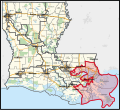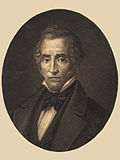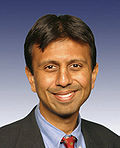History
Since at least the 1840s, the 1st congressional district has been anchored in and around most of the Greater New Orleans area south of Lake Pontchartrain, with the district being anchored in most of the city itself, as well as the adjoining parishes of St. Bernard and Plaquemines, during most of the tenure of F. Edward Hébert, a former journalist for The Times-Picayune who represented the district for a record 18 terms from 1941 until his retirement in 1977, eventually serving as Chairman of the House Armed Services Committee from 1971 to 1975. While largely a Democratic district for most of its existence, with Louisiana being part of the Solid South during this era, the district eventually became friendlier to Republicans as many conservative Democrats began to increasingly vote Republican (or at least against the Democratic presidential nominee), with the district even giving a plurality of the vote to George Wallace in 1968.
In the 1970s round of redistricting, the Louisiana State Legislature (in complying with the Voting Rights Act of 1965, particularly the opportunity of racial minorities to elect a representative of their choosing) redrew the neighboring 2nd District, which previously contained most of the western parts of New Orleans as well as the Westbank suburbs (on the west side of the Mississippi River, hence the term) in neighboring Jefferson Parish, into a majority African American district. In exchange, the 1st District would now extend to the Northshore area (the Florida Parishes north of Lake Pontchartrain) for the first time, adding St. Tammany Parish which had been amongst the first areas of Louisiana to turn Republican in the post-World War II era. Accordingly, the new 1st gave Republican President Richard Nixon over 70 percent of the vote in his 1972 reelection, though it did give a narrow majority to Democrat Jimmy Carter in 1976. That same year, longtime incumbent Hébert retired from Congress, and was succeeded by State Representative and fellow Democrat Richard Tonry, who narrowly won the election that year over Republican assistant state attorney general Bob Livingston.
However, Tonry would quickly become the subject of a federal corruption investigation, including allegations of ballot stuffing in St. Bernard Parish as well as illegal campaign contributions, eventually pleading guilty, serving a six-month prison sentence and resigning from Congress after only four months in May 1977. In the ensuing special election, Livingston would defeat Democratic State Representative Ron Faucheux (who himself defeated Tonry in his party's primary for the special election), becoming the first Republican to represent the district as well as a large portion of New Orleans since Reconstruction; the district would also narrowly vote for Ronald Reagan in the 1980 presidential election.
In the 1980s round of redistricting, the district shed virtually all of its precincts outside of New Orleans and Jefferson and St. Tammany parishes, with a mid-decade redistricting in 1984 making the district even more Republican. In particular, several central and eastern portions of New Orleans that were becoming increasingly African American and Democratic (including in particular New Orleans East, which would be adversely affected by the 1980s oil glut and the ensuing demographic changes that affected property values and crime rates there) were moved to the itself majority African American 2nd District. In exchange, the 1st added several heavily Republican areas of Jefferson Parish from the 3rd District (including the East Bank suburbs of Metairie and Kenner, as well as most of the Westbank suburbs including Terrytown, Estelle and Avondale) that not unlike St. Tammany Parish experienced a similar trend towards the GOP after World War II. From this newly redrawn district, Livingston (who himself would relocate from New Orleans to Metairie following the 1984 redistricting) would go on to win by margins exceeding 80 percent or higher, doing so in some cases unopposed, as the 1st became the most heavily Republican district in Louisiana and one of the most heavily Republican districts in the nation. [4] President Reagan won more than 77 percent of the vote in the district in 1984, followed by 71 percent in 1988 for George H. W. Bush, who himself accepted his party's presidential nomination at the Republican National Convention held that year in New Orleans at the Louisiana Superdome.
In the 1990s round of redistricting, the district expanded deeper into the Florida Parishes, gaining Washington and most of Tangipahoa parishes from the 6th District, in addition to the same core of Saint Tammany Parish, most of Jefferson Parish and a northwestern portion of New Orleans centered on the Lakeview neighborhood (long considered one of the more Republican areas of the heavily Democratic city) associated with the district since the 1970s. During this decade, Livingston rose to become Chairman of the powerful House Appropriations Committee following the Republican takeover of the House of Representatives following the 1994 elections, and in 1996 the 1st District would be the only district in Louisiana to vote for Bob Dole (who would also be the last Republican to lose Louisiana in a presidential election as of 2025). After Livingston resigned from Congress in 1999 following a short-lived bid for Speaker of the House that unraveled upon revelations of an extramarital affair from years past, the district would remain in Republican hands, electing State Representative David Vitter to succeed Livingston.
In the 2000s round of redistricting, the district would become equally divided on both sides of Lake Pontchartrain, connected only by the Lake Pontchartrain Causeway, with the slightly larger northern half consisting of the Florida Parishes of St. Tammany, Tangipahoa and Washington and the southern half consisting of most of Jefferson Parish, along with the Lakeview area of New Orleans carried over from the previous district and a section of St. Charles Parish extending as far west as Destrehan. With the smallest percentage of African Americans amongst Louisiana's then-delegation of seven congressional districts, the district was also the most Republican district in the state, giving over 70 percent of the vote to George W. Bush in 2004 and 72 percent to John McCain in 2008. Two of the district's representatives would eventually move up to higher office, with Vitter becoming the first Republican to be popularly elected to the Senate from Louisiana (and the first Republican Senator from the state since Reconstruction) in 2004 and Vitter's successor Bobby Jindal (also a Republican) being elected Governor of Louisiana in 2007. Jindal's successor, Republican Steve Senator Steve Scalise, would be elected in 2008 to succeed Jindal.
In 2012, following the 2010s round of redistricting which saw Louisiana lose a congressional seat due to population declines in the wake of Hurricane Katrina (which caused massive flooding and population displacement in the Greater New Orleans area), the district shed Washington and most of Tangipahoa parishes in the Northshore, while gaining back St. Bernard and Plaquemines parishes for the first time since the early 1980s, and also gaining most of Lafourche Parish and southern Terrebonne Parish (historically associated with the previous 3rd District, which had been eliminated and combined with the old 7th district) for the first time. Following the 2012 election, Scalise would be elected as Chairman of the powerful Republican Study Committee, eventually rising to House Majority Whip after the 2014 elections, becoming House Minority Whip after the GOP lost control of the House in the 2018 elections, and eventually House Majority Leader after the 2022 elections.
Throughout Scalise's time as the district's representative, the district has remained solidly Republican, giving more than two-thirds of the vote to Donald Trump in all three of his presidential elections between 2016 and 2024, with unprecedented Republican support in more rural areas of the district balancing out slight underperformances in more historically Republican suburban parts of the district during the Trump era. The district also voted twice against Democrat John Bel Edwards (who hails from just outside the district in Tangipahoa Parish) in both his successful election as Governor in 2015 and his reelection in 2019, with the 1st being the only district in Louisiana to vote for Edwards' Republican challenger, then-U.S. Senator and former 1st District representative David Vitter, in the former election.
As of the 2020s round of redistricting, as well as a subsequent mid-decade redistricting that resulted in a second majority-African American district being created before the 2024 elections, the district remains about equally divided on both sides of Lake Pontchartrain, with the northern portion extending from all of St. Tammany Parish to southern portions of Tangipahoa, Livingston and Ascension parishes (the latter two located in the Baton Rouge metropolitan area) including as far west as Sorrento, and the southern portion split between Scalise's political base in the East Bank suburbs west of New Orleans on one end and the southeastern corner of the state across most of St. Bernard, Plaquemines and Lafourche parishes. Despite this fact, the district in its latter-day iteration has yet to be represented by a resident from north of Lake Pontchartrain. [5] The reformulation of the 1st congressional district so that it virtually surrounds "the nation's second-largest saltwater lake" has generated a local joke that the voters in the district are outnumbered by the fish.




























